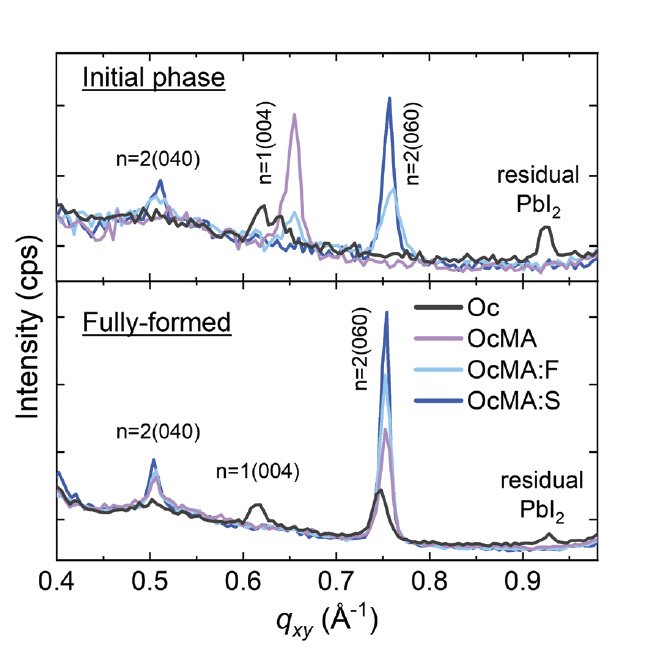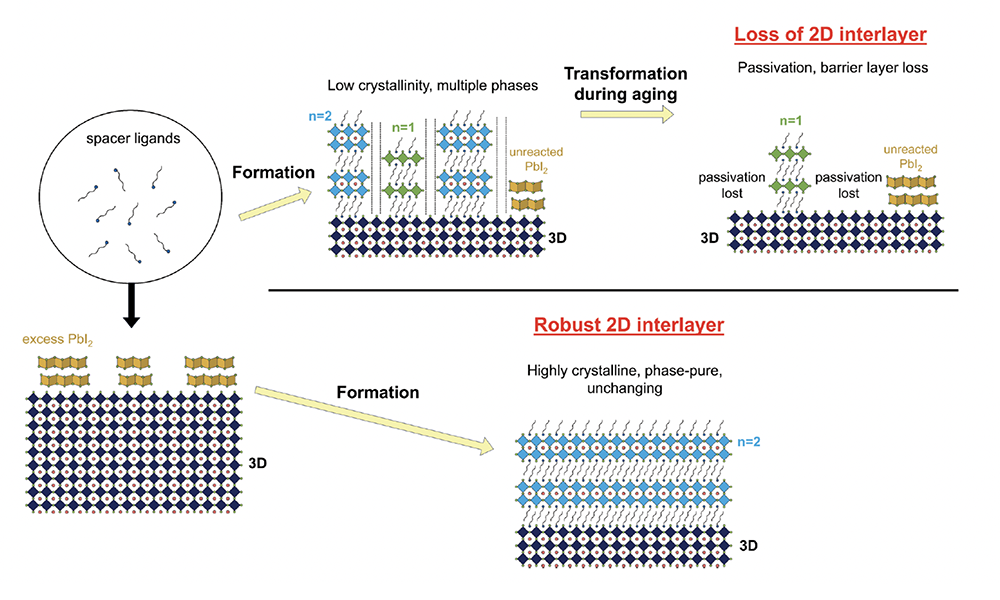Scientific Achievement
Researchers optimized thin film deposition of 2D perovskites using a mixed solvent approach to achieve phase purity and high crystallinity.
Significance and Impact
This result paves the way for commercially viable, high-performance, and long-lasting electronic and photonic devices.

Multi-layer perovskites key to optoelectrical performance
Two-dimensional on three-dimensional (2D/3D) perovskite bilayer heterostructures have the potential to boost the performance and durability of many types of electronic and photonic devices, including photovoltaics, light-emitting diodes, photodetectors, lasers, and transistors, but maintaining this performance depends on the stability of the cell’s 2D interlayer.
In this sandwich-like 2D/3D structure, the 2D interlayer consists of monolayer or multilayer stacks of hybrid organic–inorganic halide perovskites. The 2D interlayer protects the 3D perovskite in the stack by reducing negative effects from defects in the material, controlling the movement of electrons or ions through the material, creating a built-in potential, preventing the movement of ions or electrons from the environment into the material, and blocking ion migration. This interlayer improves power conversion efficiency and device stability. As the device ages, the 2D interlayer can evolve differently, altering device stability.
Strengthening perovskite’s weak link
In this study, researchers developed a durable 2D interlayer to improve the efficiency and longevity of the 2D/3D perovskite bilayer heterostructures. At Lawrence Berkeley National Laboratory, the team prepared all of the chemical compounds used in the production of the 2D interlayer at the Molecular Foundry. In the experiments, they used four solvents based on methylammonium (MA), a cation commonly used in the production of perovskite solar cells. Each solvent composition increased in complexity—octylammonium (Oc), OcMA (Oc ligand with MA additive in isopropanol (IPA)), OcMA:F (OcMA with mixed dimethylformamide and IPA), and OcMA:S (OcMA with mixed dimethyl sulfoxide and IPA).
The researchers used a custom-built, spin-coating chamber at Beamline 12.3.2 of the Advanced Light Source to crystallize each solvent as a 2D thin film interlayer on the 3D perovskite structure. As the thin film formed, the team collected grazing-incidence wide-angle x-ray scattering (GIWAXS) data at the beamline. They used the near instantaneous scattering data to evaluate the dynamic evolution of the crystalline structures and phase purity of each thin film to understand the resulting functional properties of the samples.
The researchers found that all of the mixed solvent strategies produced phase-pure 2D perovskites. These results allowed them to exclude phase purity as a contributing factor in the 2D interlayer degradation.
The team then turned their attention to crystallinity and found it correlated with carrier lifetime of the 2D/3D devices, before and after illumination. In particular, crystallinity increased with solvent complexity (i.e., Oc < OcMA < OcMA:F < OcMA:S). Samples composed with the solution OcMA:S spontaneously formed the 2D thin film during the initial phase and had the highest final 2D crystallinity, phase purity, and durability.
Achieving a robust 2D interlayer
The researchers found that OcMA:S reached 25.9% efficiency, which is comparable to the best-reported, single-junction silicon solar cells. In accelerated tests at 85°C under peak power conditions, the OcMA:S perovskite retained 91% of its initial performance after 1,074 hours, one of the most stable for this type of perovskite device. This advancement tackles a key stability barrier to commercialization and offers design principles for building robust heterostructures with broad applications in optoelectronics.

Contacts: Shaun Tan and Moungi Bawendi
Researchers: S. Tan, M. Shih, Y. Lu, M.J. Grotevent, Y. Lin, H. Zhu, R. Zhang, V. Bulović, and M.G. Bawendi (Massachusetts Institute of Technology); S. Choi, J.H. Lee, N. Park, and J.W. Lee (Sungkyunkwan University, Republic of Korea); Y. Dong, B.W. Larson, S.Y. Park, M.C. Beard, and K. Zhu (National Renewable Energy Laboratory); I. Yavuz (Marmara University, Turkey); T. Kodalle (ALS, Molecular Foundry); C.M. Sutter-Fella (Molecular Foundry)
Funding: US Department of Energy (DOE), Office of Energy Efficiency and Renewable Energy (EERE); US DOE Office of Science, Office of Basic Energy Sciences; US DOE Office of Science, Center for Hybrid Organic-Inorganic Semiconductors for Energy; National Research Foundation of Korea; and First Solar, Inc. Operation of the ALS and Molecular Foundry is supported by DOE BES.
Publication: S. Tan, M. Shih, Y. Lu, S. Choi, Y. Dong, J.H. Lee, I. Yavuz, B.W. Larson, S.Y. Park, T. Kodalle, R. Zhang, M.J. Grotevent, Y. Lin, H. Zhu, V. Bulović, C.M. Sutter-Fella, N. Park, M.C. Beard, J.W. Lee, K. Zhu, and M.G. Bawendi, “Spontaneous formation of robust two-dimensional perovskite phases,” Science 388, 6747 (2025). doi:10.1126/science.adr1334.
ALS SCIENCE HIGHLIGHT #525